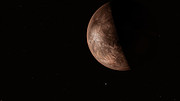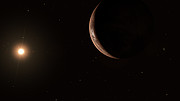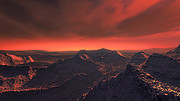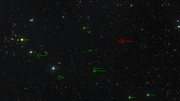Artist’s impression of the distinctive substructure in a protoplanetary disk formed a few hundred thousand years after the birth of the central star. Credit: Y. Nakamura, A. Shoshi et al.
A scatter plot of bolometric temperatures and dust disk radii of the sources investigated in this study and those observed in the eDisk project. Purple, red, and yellow markings indicate disks with characteristic structures or potential ones with substructures. A bolometric temperature of 650 K corresponds to a disk around a central star that has evolved for about one million years since its formation, suggesting that characteristic substructures begin to emerge at even earlier stages. Credit: A. Shoshi et al.
A comparison of images of protoplanetary disks in the Ophiuchus star-forming region, created with super-resolution imaging with sparse modelling versus a conventional imaging method. The resolution is indicated by the white ellipse in the lower left corner of each panel, with a smaller ellipse denoting higher resolution. The white line in the lower right of each panel indicates a scale of 30 AU. The evolution stage of the central stars progresses from left to right, and from top to bottom in the same row. Credit: ALMA(ESO/NAOJ/NRAO), A. Shoshi et al.
A research team led by Ayumu Shoshi of Kyushu University and the
Academia Sinica Institute of Astronomy and Astrophysics (ASIAA) revealed
protoplanetary disks around protostars that had not been clearly
observed in previous analyses, by employing a new imaging technique with
sparse modeling on ALMA archival data. The targets were 78 disks in the
Ophiuchus star-forming region. These disks composed of gas and dust
that form around protostars immediately after their birth are, so to
speak, the cradles of planets. The new technique revealed various
characteristic disk substructures, including rings and spirals, that
were previously undetectable with conventional methods. Notably, these
distinctive substructures were found for a significant number of stars
in their early formation stages, approximately several hundred thousand
years after the star birth. This suggests the possible coevolution of
stars and planets in a gas and dust rich environment, providing an
important clue to understanding the process of planet formation.
Identifying the formation period of planetary systems, such as our Solar System, could be the beginning of the journey to discover the origin of life. The key to this is the unique substructures found in protoplanetary disks – the sites of planet formation. A protoplanetary disk is composed of low-temperature molecular gas and dust, surrounding a protostar. If a planet exists in the disk, its gravity will gather or eject materials within the disk, forming characteristic substructures such as rings or spirals. In other words, various disk substructures can be interpreted as “messages” from the forming planets. To study these substructures in detail, high-resolution radio observations with ALMA are required.
Numerous ALMA observations of protoplanetary disks (or circumstellar disks) have been conducted so far. In particular, two ALMA large programs, DSHARP and eDisk, have revealed the detailed distribution of dust in protoplanetary disks through high-resolution observations. The DSHARP project discovered that distinctive structures are common in circumstellar disks around 20 young stars, each exceeding one million years since the onset of star formation (see note below). On the other hand, fewer distinctive structures were found by the eDisk project that investigated disks around 19 protostars in the accretion phase (the stage where mass accretion onto the star and the disk is active). This phase occurs approximately 10,000 to 100,000 years after star birth. This suggests that disks have diverse characteristics depending on the age of the star.
Here, the question is when do substructures, the signs of planet formation, appear in disks. To find the answer, it is necessary to observe disks of a wide range of intermediate ages that have yet to be explored. However, limitations on the number of disks observable at high resolution, due to distance and observational time, make it challenging to conduct a statistically significant survey with a sufficiently large sample size.
To overcome these limitations, the research team turned to super-resolution imaging with sparse modeling. In radio astronomy, images are commonly restored based on a specific assumption to compensate for missing observation data. The imaging method employed this time reconstructs based on a more accurate assumption than the conventional approach, producing higher-resolution images even though the same observation data is used. PRIISM (Python module for Radio Interferometry Imaging with Sparse Modeling), the public software developed by a Japanese research team was used in this study. The research team utilized this new imaging technique on ALMA archival data, targeting 78 disks in the Ophiuchus star-forming region, located 460 light years from the Solar System.
As a result, more than half of the images produced in this study achieved a resolution over three times higher than that of the conventional method, which is comparable to that of the DSHARP and eDisk projects (Figure 1). Moreover, the total number of samples in this study is nearly four times larger than that of the previous two projects, significantly improving the robustness of our statistical analysis. Among the analyzed 78 disks, 27 disks were revealed to have ring or spiral structures, 15 of which were identified for the first time in this study.
The team combined the Ophiuchus sample with those of the eDisk project to conduct a statistical analysis. As a result, they found that the characteristic disk substructures emerge in disks with radii larger than 30 astronomical units (au) during the early stage of star formation, just a few hundred thousand years after a star was born (Figure 2). This suggests that planets begin to form at a much earlier stage than previously believed, when the disk still possesses abundant gas and dust (Figure 3). In other words, planets grow together with their very young host stars. Ayumu Shoshi says, “These findings, bridging the gap between the eDisk and DSHARP projects, were enabled by the innovative imaging that allows for both achieving high resolution and a large number of samples. While these findings only pertain to the disks in the constellation Ophiuchus, future studies of other star-forming regions will reveal whether this tendency is universal.”
Identifying the formation period of planetary systems, such as our Solar System, could be the beginning of the journey to discover the origin of life. The key to this is the unique substructures found in protoplanetary disks – the sites of planet formation. A protoplanetary disk is composed of low-temperature molecular gas and dust, surrounding a protostar. If a planet exists in the disk, its gravity will gather or eject materials within the disk, forming characteristic substructures such as rings or spirals. In other words, various disk substructures can be interpreted as “messages” from the forming planets. To study these substructures in detail, high-resolution radio observations with ALMA are required.
Numerous ALMA observations of protoplanetary disks (or circumstellar disks) have been conducted so far. In particular, two ALMA large programs, DSHARP and eDisk, have revealed the detailed distribution of dust in protoplanetary disks through high-resolution observations. The DSHARP project discovered that distinctive structures are common in circumstellar disks around 20 young stars, each exceeding one million years since the onset of star formation (see note below). On the other hand, fewer distinctive structures were found by the eDisk project that investigated disks around 19 protostars in the accretion phase (the stage where mass accretion onto the star and the disk is active). This phase occurs approximately 10,000 to 100,000 years after star birth. This suggests that disks have diverse characteristics depending on the age of the star.
Here, the question is when do substructures, the signs of planet formation, appear in disks. To find the answer, it is necessary to observe disks of a wide range of intermediate ages that have yet to be explored. However, limitations on the number of disks observable at high resolution, due to distance and observational time, make it challenging to conduct a statistically significant survey with a sufficiently large sample size.
To overcome these limitations, the research team turned to super-resolution imaging with sparse modeling. In radio astronomy, images are commonly restored based on a specific assumption to compensate for missing observation data. The imaging method employed this time reconstructs based on a more accurate assumption than the conventional approach, producing higher-resolution images even though the same observation data is used. PRIISM (Python module for Radio Interferometry Imaging with Sparse Modeling), the public software developed by a Japanese research team was used in this study. The research team utilized this new imaging technique on ALMA archival data, targeting 78 disks in the Ophiuchus star-forming region, located 460 light years from the Solar System.
As a result, more than half of the images produced in this study achieved a resolution over three times higher than that of the conventional method, which is comparable to that of the DSHARP and eDisk projects (Figure 1). Moreover, the total number of samples in this study is nearly four times larger than that of the previous two projects, significantly improving the robustness of our statistical analysis. Among the analyzed 78 disks, 27 disks were revealed to have ring or spiral structures, 15 of which were identified for the first time in this study.
The team combined the Ophiuchus sample with those of the eDisk project to conduct a statistical analysis. As a result, they found that the characteristic disk substructures emerge in disks with radii larger than 30 astronomical units (au) during the early stage of star formation, just a few hundred thousand years after a star was born (Figure 2). This suggests that planets begin to form at a much earlier stage than previously believed, when the disk still possesses abundant gas and dust (Figure 3). In other words, planets grow together with their very young host stars. Ayumu Shoshi says, “These findings, bridging the gap between the eDisk and DSHARP projects, were enabled by the innovative imaging that allows for both achieving high resolution and a large number of samples. While these findings only pertain to the disks in the constellation Ophiuchus, future studies of other star-forming regions will reveal whether this tendency is universal.”
Scientific Paper
Note
The evolutionary stage of a protostar is estimated using the
bolometric temperature around the star. The bolometric temperature is an
apparent temperature derived from the total brightness of an object
across all wavelengths. A higher bolometric temperature indicates a more
advanced evolutionary stage, and a temperature of 650 K suggests that
approximately one million years have passed since the birth of the star.
Additional Information
This research has been published in The Publications of the Astronomical Society of Japan on April 22, 2025, as Ayumu Shoshi et al. “ALMA 2D super-resolution imaging survey of Ophiuchus Class I/flat spectrum/II disks. I. Discovery of new disk substructures” (DOI: https://doi.org/10.1093/pasj/psaf026)
Co-researchers: Masayuki Yamaguchi (ASIAA), Takayuki Muto (Kogakuin University), Naomi Hirano (ASIAA), Ryohei Kawabe (Graduate School of Advanced Studies, SOKENDAI/National Astronomical Observatory of Japan), Takashi Tsukagoshi (Ashikaga University), and Masahiro Machida (Kyushu University)
The original press release was published by the National Astronomical Observatory of Japan (NAOJ), an ALMA partner on behalf of East Asia.
The Atacama Large Millimeter/submillimeter Array (ALMA), an international astronomy facility, is a partnership of the European Southern Observatory (ESO), the U.S. National Science Foundation (NSF), and the National Institutes of Natural Sciences (NINS) of Japan in cooperation with the Republic of Chile. ALMA is funded by ESO on behalf of its Member States, by NSF in cooperation with the National Research Council of Canada (NRC) and the National Science and Technology Council (NSTC) in Taiwan, and by NINS in cooperation with the Academia Sinica (AS) in Taiwan and the Korea Astronomy and Space Science Institute (KASI).
ALMA construction and operations are led by ESO on behalf of its Member States; by the National Radio Astronomy Observatory (NRAO), managed by Associated Universities, Inc. (AUI), on behalf of North America; and by the National Astronomical Observatory of Japan (NAOJ) on behalf of East Asia. The Joint ALMA Observatory (JAO) provides the unified leadership and management of ALMA's construction, commissioning, and operation.
Additional Information
This research has been published in The Publications of the Astronomical Society of Japan on April 22, 2025, as Ayumu Shoshi et al. “ALMA 2D super-resolution imaging survey of Ophiuchus Class I/flat spectrum/II disks. I. Discovery of new disk substructures” (DOI: https://doi.org/10.1093/pasj/psaf026)
Co-researchers: Masayuki Yamaguchi (ASIAA), Takayuki Muto (Kogakuin University), Naomi Hirano (ASIAA), Ryohei Kawabe (Graduate School of Advanced Studies, SOKENDAI/National Astronomical Observatory of Japan), Takashi Tsukagoshi (Ashikaga University), and Masahiro Machida (Kyushu University)
The original press release was published by the National Astronomical Observatory of Japan (NAOJ), an ALMA partner on behalf of East Asia.
The Atacama Large Millimeter/submillimeter Array (ALMA), an international astronomy facility, is a partnership of the European Southern Observatory (ESO), the U.S. National Science Foundation (NSF), and the National Institutes of Natural Sciences (NINS) of Japan in cooperation with the Republic of Chile. ALMA is funded by ESO on behalf of its Member States, by NSF in cooperation with the National Research Council of Canada (NRC) and the National Science and Technology Council (NSTC) in Taiwan, and by NINS in cooperation with the Academia Sinica (AS) in Taiwan and the Korea Astronomy and Space Science Institute (KASI).
ALMA construction and operations are led by ESO on behalf of its Member States; by the National Radio Astronomy Observatory (NRAO), managed by Associated Universities, Inc. (AUI), on behalf of North America; and by the National Astronomical Observatory of Japan (NAOJ) on behalf of East Asia. The Joint ALMA Observatory (JAO) provides the unified leadership and management of ALMA's construction, commissioning, and operation.
Contacts:
Nicolás Lira
Education and Public Outreach Coordinator
Joint ALMA Observatory, Santiago - Chile
Phone: +56 2 2467 6519
Cel: +56 9 9445 7726
Email: nicolas.lira@alma.cl
Yuichi Matsuda
ALMA EA-ARC Staff Member
NAOJ
Email: yuichi.matsuda@nao.ac.jp
Jill Malusky
Public Information Officer
NRAO
Phone: +1 304-456-2236
Email: jmalusky@nrao.edu
Bárbara Ferreira
ESO Media Manager
Garching bei München, Germany
Phone: +49 89 3200 6670
Email: press@eso.org











